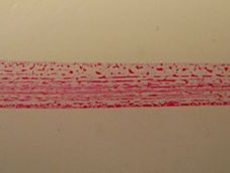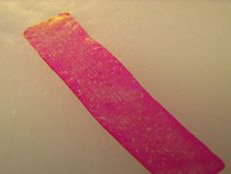
SurfaceTreat
PLASMA – green technology of surface treatment
Plasma treated powders for rotational molding
Powders for rotational molding (more info on http://en.wikipedia.org/wiki/Rotational_molding) – plasma treatment of powder enables to increase surface energy of particles, which is kept also after sintering on the product surface. It leads to higher wettability and adhesion capability of the product surface.Material is though suitable for applications requiring very good adhesion such as foaming
with PU – results of application test see in the section Testing methods – Adhesion to PU foams
It is proved that significant enhancement of PE/PU adhesion is reached also with mixture of plasma treated and untreated material, e.g., ratio 50/50. We provide the mixing according to requirements in our plant.
Our offer in the area of hydrophilisation of powder materials you can find in the section Services.
Products sintered from plasma treated powder are directly prepared for final processing without any additional pretreatment such as flame, chemical or mechanical processes.
The enhanced adhesion properties can be used in following areas:
- production of foamed parts or containers with PU foam, for example seats or insulated containers – advantage – simpler construction by means of improved resistence against the mechanical stress of the final product.
- multilayer rotomolding – creation of inner barrier layer
- production of parts with inserts such as valve, outlet, etc.
We have experience with the following types of rotomolding powders:
BORECENE RM 8343, mPE M 3581 UV S01, SURPASS RMS 244 UG, DOWLEX 2631.10UE, DOWLEX 2629.10UE, ICORENE 3590, ICORENE 3560, ICORENE 1613 BK 85, LUPOLEN 3621 M RM, LUPOLEN 4021 K RM, Microline ML 73, RX 101 black 9003, PolyLink PL 4632, Egyeuroptene LLD 3505, REVOLVE N-307, REVOLVE N-250, etc.
Portfolio is widening according to demand and our development.
Stability of the plasma treatment – treated material can be stored under standard conditions for long time period without loss of the treatment effect.
Measurement of the effect by Washburne method you can see in the section Testing methods – Wettability – powder materials. It shows that even after 1 year there are the same values as just after treatment and loss approx. of 20 % after 3 years was measured.
Measurement of surface energy on sintered surface is described in the section Testing methods – surface wettability.
Plasma surface treatment effect
- sintered samples after treatment – surface energy 44 mN/m
- sintered samples from untreated powder – surface energy 30 mN/m
- limit value for good adhesion – 38 mN/m
- always depending on the type of material and the treatment intesity compared to the sample sintered from untreated powder

Test on the sintered surface from untreated powder – surface energy is below the limit of 38 mN/m. (Arcotest Quicktest® 38)

Test on the sintered surface from plasma treated powder – surface energy is 38 mN/m or above. (Arcotest Quicktest® 38)
Practicle example of testing inks for surface energy measurement you can see in video sequence Surface energy of sintered surfaces.
Proudly created by Meatballs, s.r.o., 2017